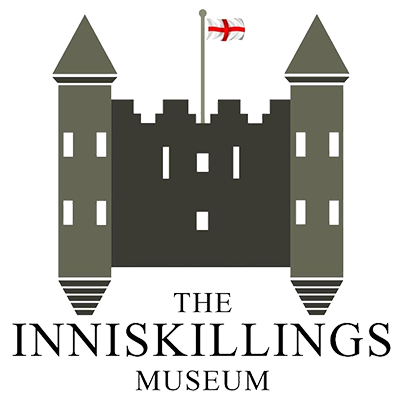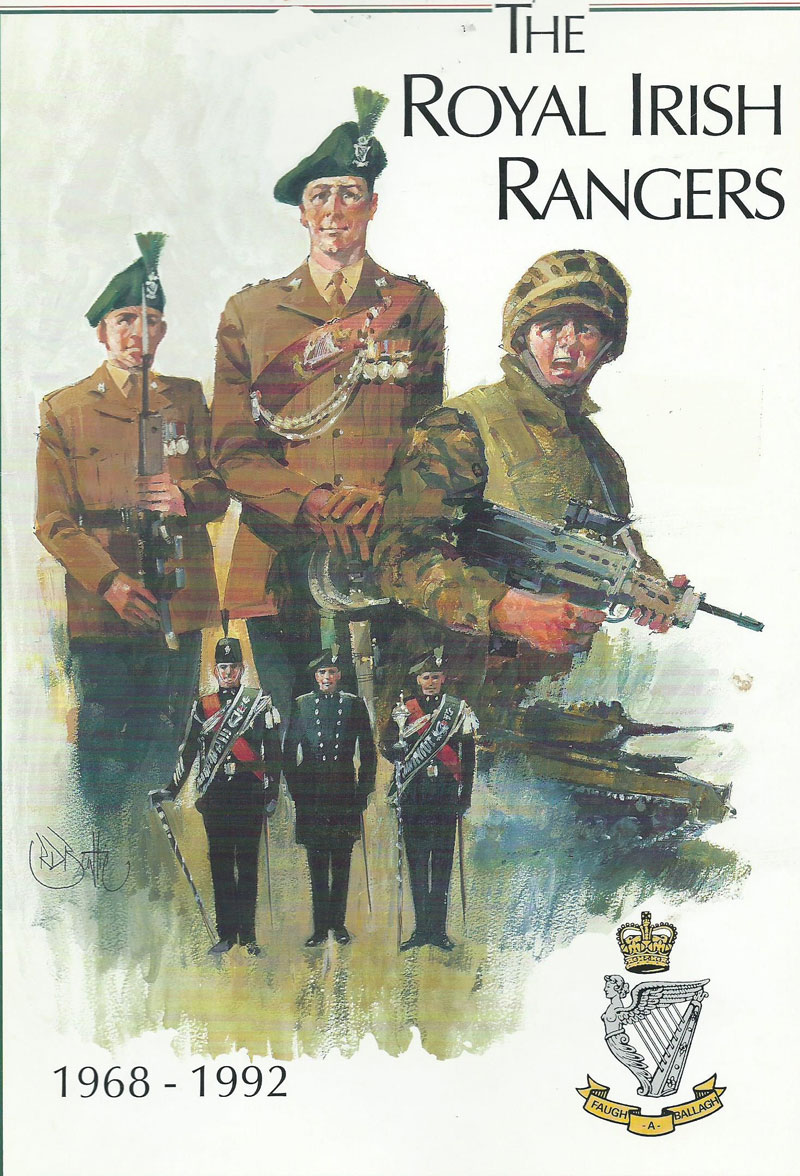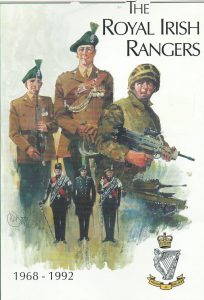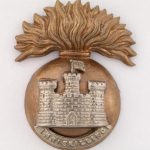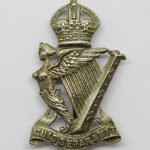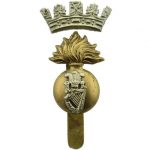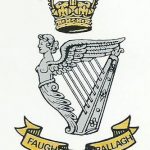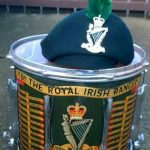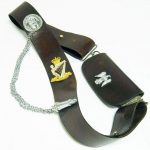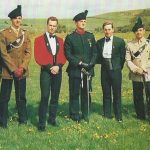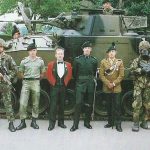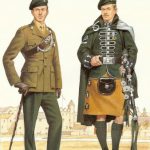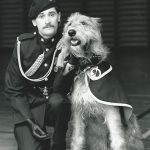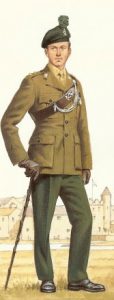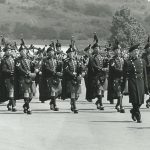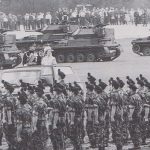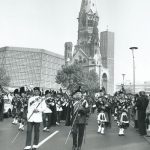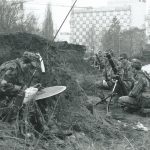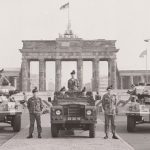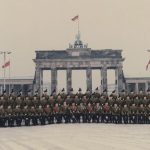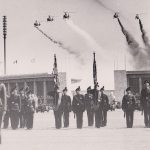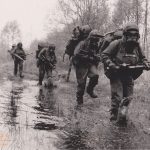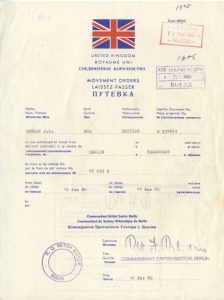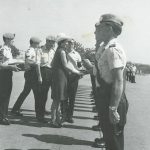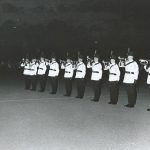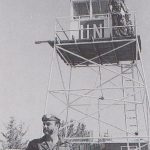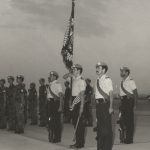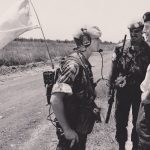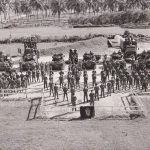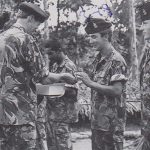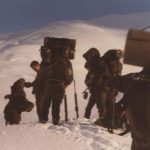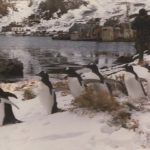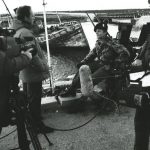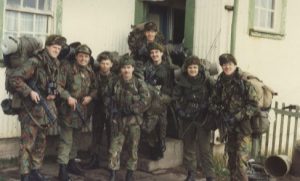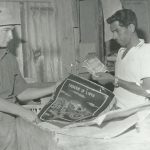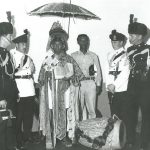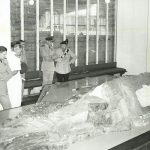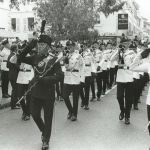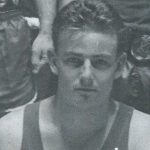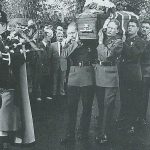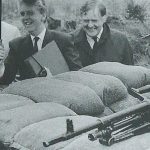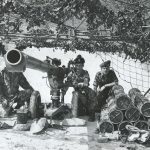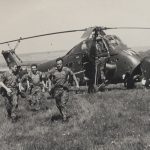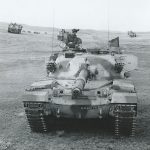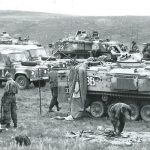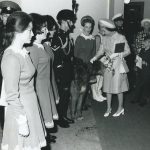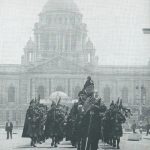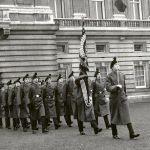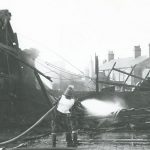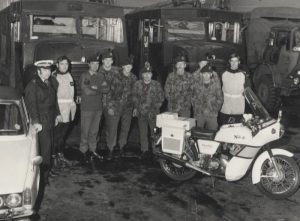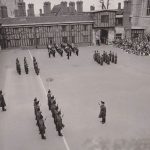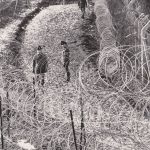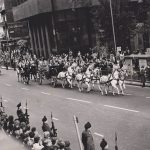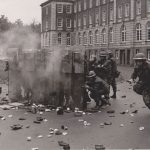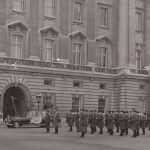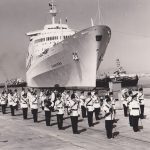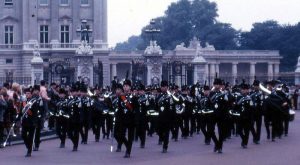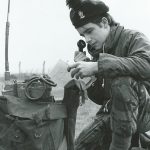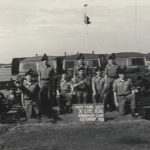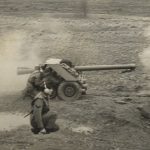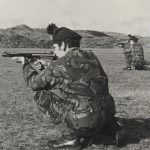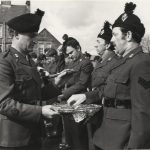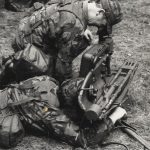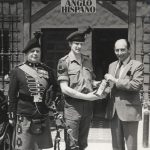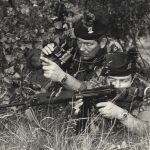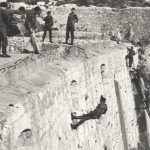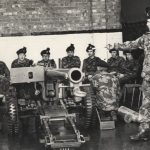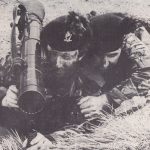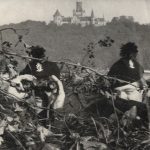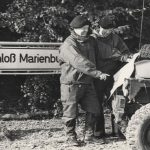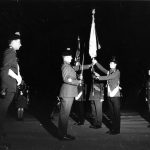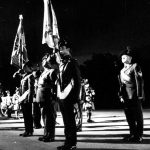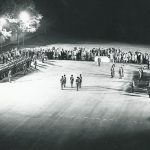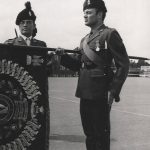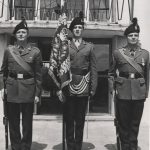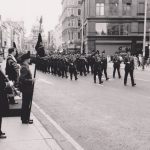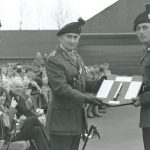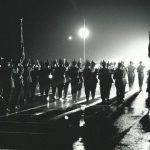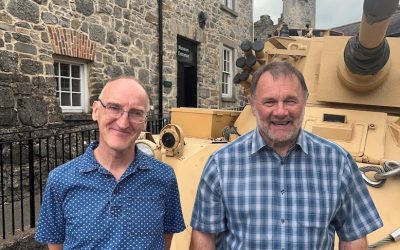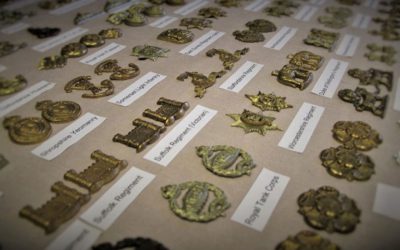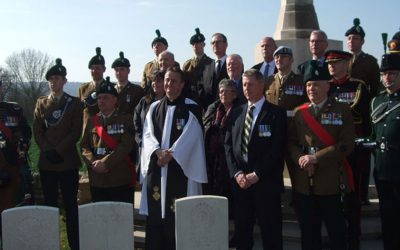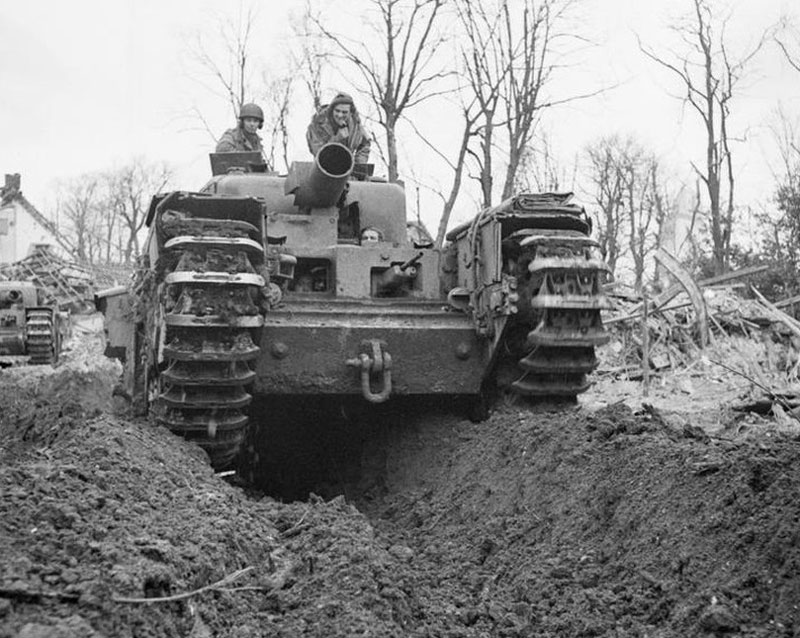The Rangers were formed out of three historic regiments which were based in Northern Ireland, Royal Inniskilling Fusiliers, Royal Ulster Rifles and Royal Irish Fusiliers.
- Royal Inniskilling Fusiliers
- Royal Ulster Rifles
- Royal Irish Fusiliers
“Vesting Day” was 1st July 1968. It was called this, not amalgamation, to emphasise that the traditions of the old regiments would be vested in the Royal Irish Rangers.
The three battalions, 1st Royal Inniskilling Fusiliers in Worcester, 1st Royal Ulster Rifles in Gibraltar, and 1st Royal Irish Fusiliers in Catterick, would be vested into two battalions of the new regiment. The Royal Irish Fusiliers Battalion was officially disbanded on 3rd December.
On Vesting Day, emotional ceremonies were held as the three historic regiments passed into history. The Inniskillings’ ceremony was held in Worcester at midnight on 30th/1st July. The other two battalions held daylight ceremonies in Gibraltar and Catterick. There was also a parade in Ballymena to mark the new regimental headquarters
No officer, Warrant officer, Non-Commissioned officer, Fusilier or Rifleman was posted back to his original regiment, and therefore no battalion of the new regiment could claim exclusive representation of its previous parent.
Dress
This was to be distinctive and striking, as well as maintaining certain aspects and characteristics of the former regiments.
A green caubeen was adopted as headgear, with the green hackle of the Royal Irish Fusiliers. The castle collar badges of the Royal Inniskilling Fusiliers were worn as were the black buttons of the Royal Ulster Rifles.
- Caubeen and Drum
- Rangers Officer’s Cross Belt
A brown cross-belt for officers was a compromise between the brown Sam Browne belts of the two Fusilier regiments and the black cross-belt of the Rifles with the Royal Irish Fusiliers’ Barrosa Eagle on the pouch. All ranks would wear piper green trousers.
- Regimental Dress (1)
- Regimental Dress (2)
- Regimental Dress (3)
Two volunteer battalions of part time soldiers supported the work of the regular battalions, the 4th (Volunteer) Battalion, North Irish Militia and 5th Battalion. A large number of detachments and contingents of The Army Cadet Force and The Combined Cadet Force were affiliated to the Regiment.
The Rangers served as front line infantry throughout their short life. In 1992, the Regiment was amalgamated with the Ulster Defence Regiment to form a new regiment, The Royal Irish Regiment.
- Officer and Piper
- Regimental Mascot, Brian Boru V (1992)
- The Colours of the Royal Irish Rangers
Overseas deployments.
GERMANY
Throughout the existence of the regiment, its major overseas commitment was to the British Army of the Rhine (BAOR), part of NATO’s commitment to the defence of Europe during the Cold War. When in West Berlin, they were part of the allied army of occupation.
| 1st Battalion | 2nd Battalion |
| 1970-74 Hemer | 1974-79 Hemer |
| 1979-81 Berlin | 1981-85 Berlin |
| 1985-89 Ostnabruck | 1988 Lemgo |
- Germany 1972 – 1st Bn band at Trooping the Colour
- Germany 1977 – 2nd Bn Queen’s Silver Jubilee
- Germany 1977 – 2nd Bn Berlin Tattoo Parade
- Germany 1979 – 1st Bn Berlin
- Germany 1980 – 1st Bn Berlin
- Germany 1981 – 1st Bn Brandenburg Gate, Berlin
- Germany 1981 – B company (1st Bn) Brandenburg Gate, Berlin
- Germany 1983 – 2nd Bn Queen’s Birthday Parade – Berlin
- Germany 1989 – 1st Bn anti nuclear training – Lubeck
Cyprus
In Cyprus the battalions served under the United Nations, which was stationed in Cyprus after the violent partition of the island between the Greeks and the Turks. Both battalions served there, usually for a tour of six months.
| 1st Battalion | 2nd Battalion |
| 1971-72 | 1973 |
| 1977 | 1975 |
| 1985 |
- Cyprus 1971 – 1st Bn UN duties, with the CO UNFICYP
- Cyprus 1972 – 1st Bn, St Patrick’s Day
- Cyprus 1975 – 2nd Bn Beating Retreat
- Cyprus 1977 – 1st-Bn, UN duties
- Cyprus 1977 – 1st Bn UN medal parade
- Cyprus 1985 – 2nd Bn on patrol, UN buffer zone
Belize
Belize (formally British Honduras) is situated on the eastern coast of central America. Its neighbour, Guatemala claimed the territory, and when it became independent in 1981, refused to recognise the independence. British troops were stationed there to deter any possible incursions or aggression.
| 1st Battalion | 2nd Battalion |
| 1981-82 | 1979-80 |
- Belize 1979 -2nd Bn
- Belize 1980 – 2nd Bn
- Belize 1982 – 1st Bn, St Patrick’s Day
Falklands
After the defeat of the Argentine invasion of the Falklands in 1982, British forces garrisoned the islands in sufficient strength to deter any repeat invasion.
| 1st Battalion | 2nd Battalion |
| 1983 | 1987 |
- Falklands 1983 – 1st Bn, Garrison duty on South Georgia
- Falklands 1983 – A Ranger meets the locals in South Georgia
- Falklands 1987 – 2nd Bn CO interviewed by the press
Libya and the Gulf, Bahrain, Kuwait
These posting were part of British efforts to protect their oil interests. The Libyan posting in 1969 was at the time of the military coup which established Colonel Gadhafi in power.
| 1st Battalion | 2nd Battalion |
| 1991 Band to Kuwait as medical assistants | 1969 Libya, 1970-71 Bahrain |
- Libya 1969 – 2nd Bn
- Bahrain 1970 – 2nd Bn
- Ethiopia 1971 – 2nd Bn
Gibraltar
A significant naval base at the entrance to the Mediterranean, with a military garrison
| 2nd Battalion | |
| 1968-69 |
- Gibraltar 1968 – 2nd Bn
- Gibraltar 1969 – 2nd Bn departure
Northern Ireland. Operation Banner: 1969-2007, the army served in support of the civil powers in the campaign against the Provisional IRA.
| 1st Battalion | 2nd Battalion |
| 1988, Fermanagh and Tyrone, Op Banner | 1990, Fermanagh and Tyrone, Op Banner
Ranger Cyril Smith killed on active service in Newry |
- Northern Ireland – Ranger Cyril Smyth KIA, Newry, October 1990
- Northern Ireland – Funeral of Ranger Cyril Smyth at Carrickfergus
- Northern Ireland – Visit of the Prime Minister, Mrs Margaret Thatcher to a checkpoint
In addition to these postings, the two battalions went on overseas exercises to many countries: Denmark, USA, Canada, Jamaica, Italy, Kenya, Gibraltar Libya and France. They also fulfilled public duties in London, at the Royal Tournament, the Edinburgh Festival, fire-fighting duties in Manchester, guard duty at RAF Greenham Common.
Training
- 1974 – 1st Bn anti tank training with 120mm Wombat Anti Tank Gun
- 1st Bn training with Wessex helicopters
- 1974 – 2nd Bn mechanised Infantry training in an armoured personnel carrier (APC)
- 1976 – 2nd Bn exercise in Canada. CO in command in Main Battle Tank
- 1986 – 2nd Bn adventure training in Morocco
- 1991 – 2nd Bn exercise in Canada
Public Duties
- 1973 – 2nd Bn, Queen meets Brian Boru at the Royal Tournament
- 1976 – 1st Bn, Belfast
- 1977 – 1st Bn, Buckingham Palace
- 1977 – 1st Bn, Public Duties, Buckingham Palace
- 1978 – 1st and 2nd Bns, Royal Tournament
- 1978 – 1st Bn, fire fighting duties, Manchester
- 1984 – 1st Bn, Windsor Castle
- 1984 – 2nd Bn, Guard Duties at Greenham Common airfield
- 1984 – 2nd Bn, Street lining for state visit of French President, Francois Mitterrand
- 1985 – 2nd Bn, anti riot training
- 1986 – 2nd Bn, Buckingham Palace
- 1986 – 2nd Bn Band in Gibraltar
Cadets
- Instructor and Cadet
- Cadet operating Larkspur radio set A41
4th (Volunteer) Battalion, (North Irish Militia)
- 1968 – Training in BAOR
- 1982 – Firing a Battalion Anti Tank (BAT) recoilless rifle
- 1982 – Firing a Stirling Sub Machine Gun (SMG)
- 1983 – Shamrock Parade
- 1984 – Training with the MILAN anti tank missile system
- 1984 – Gibraltar
5th Battalion
- 1977 – On exercise in Scotland
- 1977- Training in Gibraltar
- 1979 – Training on the MOBAT anti tank weapon
- 1980 – Operating the 84mm Carl Gustav anti tank weapon
- 1980 – Germany (Schloss Marienburg), Operation Crusader, a major NATO exercise
- 1980 – Germany, Operation Crusader
Parades, from first to last
- 1968 – Inniskillings Final Parade
- 1968 – Inniskillings Final Parade (2)
- 1968 – Inniskillings Final Parade (3)
- 1972 – Presentation of Colours to 1st, 2nd and 4th Battalions
- 1976 – Warminster, Colours Parade
- 1976 – Warminster, Colours Parade (2)
- 1989 – Belfast, Tercentenary Parade
- 1992 – Ballymena, Final Recruit Passing Out Parade, presentation to the Champion Recruit
- 1992 – Warminster, Final Parade
